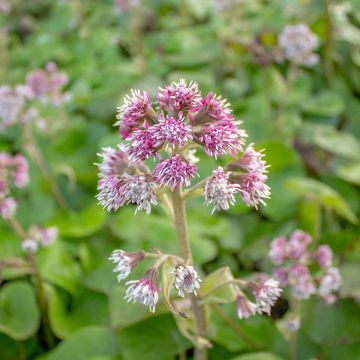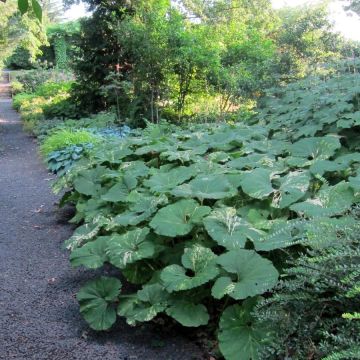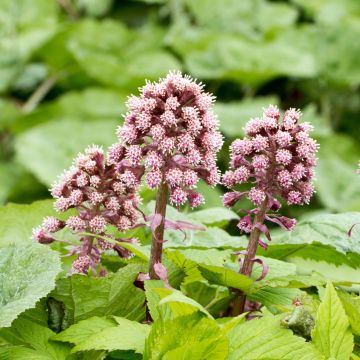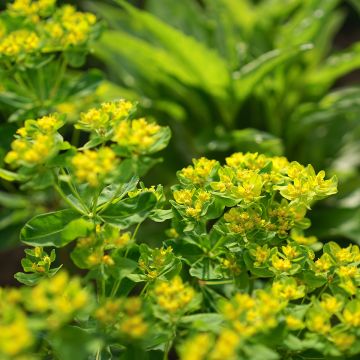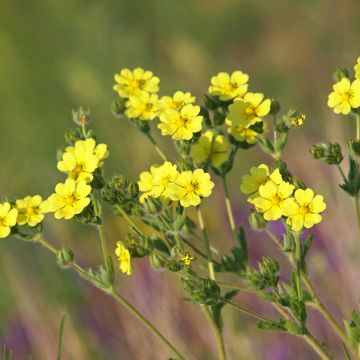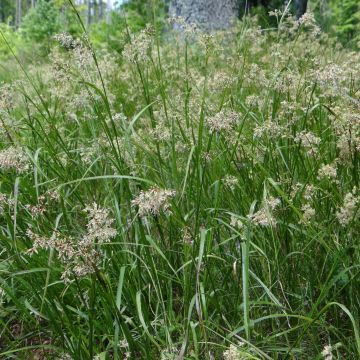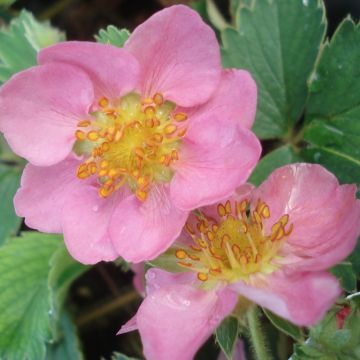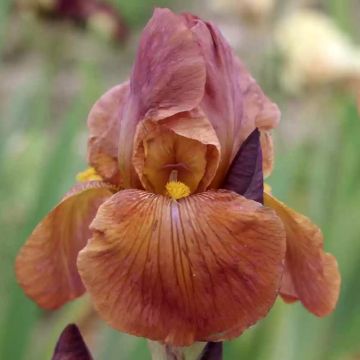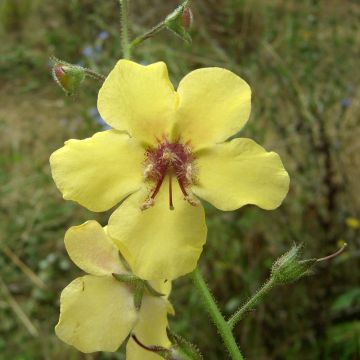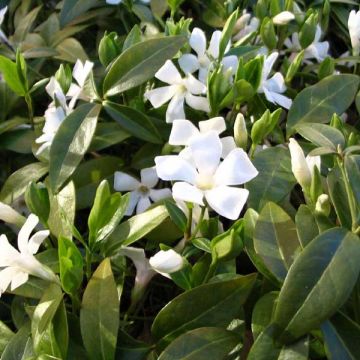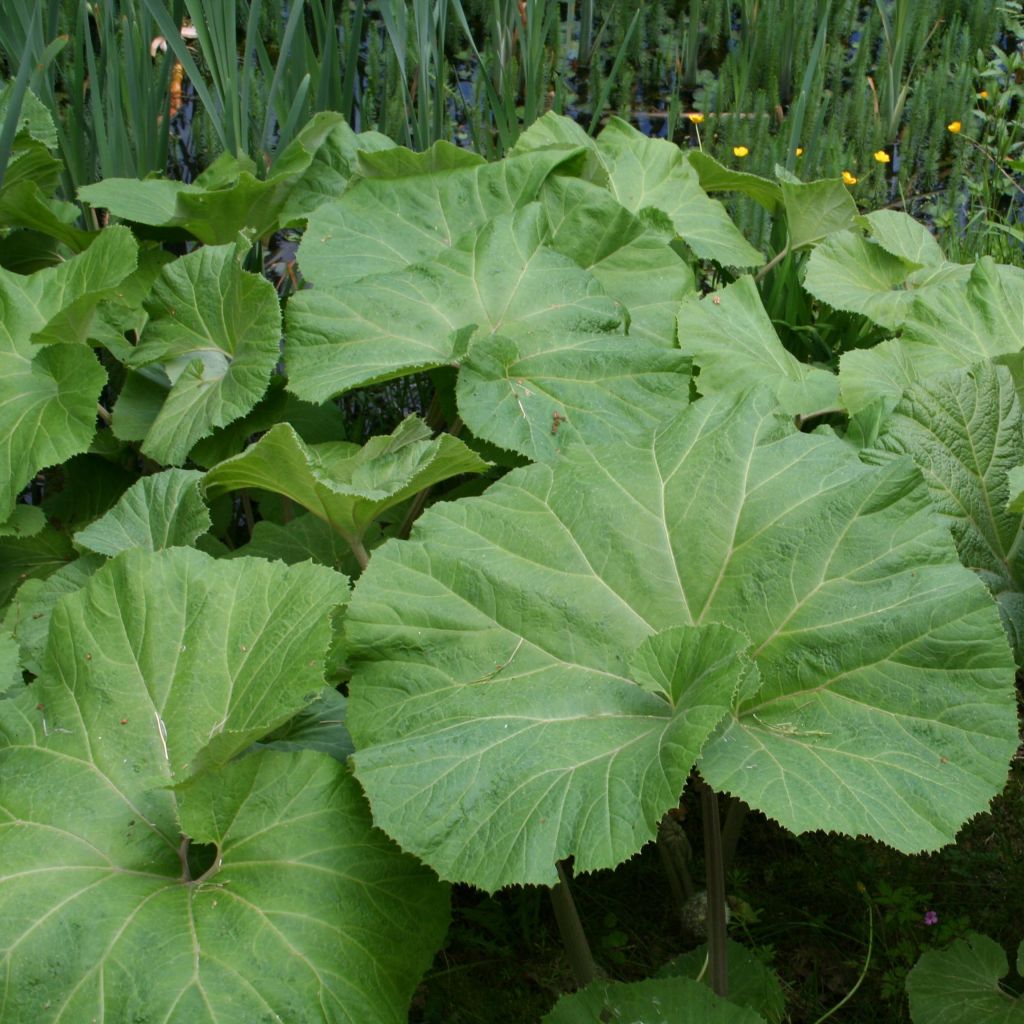

Petasites japonicus 'Giganteus'
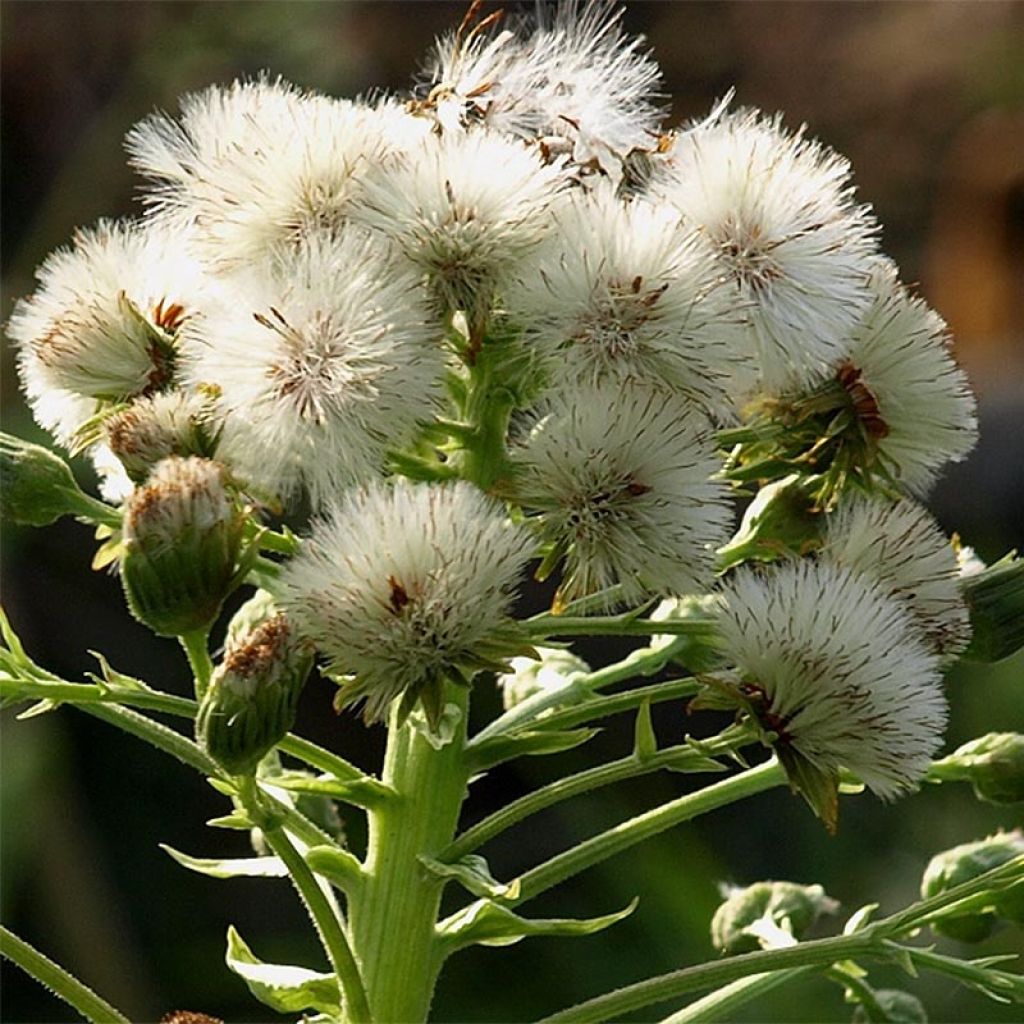

Petasites japonicus 'Giganteus'
Petasites japonicus 'Giganteus'
Petasites japonicus Giganteus
Pétasite du Japon, Fuki
This item cannot be shipped to the selected country
Delivery charge from €5.90
More information
Schedule delivery date,
and select date in basket
This plant carries a 12 months recovery warranty
More information
We guarantee the quality of our plants for a full growing cycle, and will replace at our expense any plant that fails to recover under normal climatic and planting conditions.
From €5.90 for pickup delivery and €6.90 for home delivery
Express home delivery from €8.90.
Does this plant fit my garden?
Set up your Plantfit profile →
Description
This Giganteus Petasites is a vigorous trailing rhizomatous perennial plant that thrives in shady and humid environments. Its globular flower heads, resting on a collar of pale green bracts, stretch upwards into spikes adorned with petite, fragrant, cream-coloured flowers in spring before the foliage appears. Then, large leaves with more or less dentate margins and undulated edges, measuring over 1m (3ft) in diameter, emerge. It is interesting to bring a touch of luxuriance to the wet and barren areas of a large garden, but its tendency to spread must be contained. This plant prefers humus-rich soils and dislikes scorching sun.
The japonicus Petasites is a plant native to China, Korea, and Japan. The Japanese Petasites form a vigorously spreading clump reaching 50 to 120cm (20 to 47in) but spreading indefinitely through its robust trailing rhizome—the plant flowers in March-April before the leaves appear. Emerging from grey leaves, the flower heads emerge from the ground, carried by a leafy stem, whose leaves are alternate, elongated, pointed, sessile, and very different from the large basal leaves that will appear after flowering. The flower head forms an elliptical and compact cluster, 10 to 25cm (4 to 10in) high. It consists of small female or male heads gathered in panicles. The pale green and white flowers, surrounded by light green bracts with a diameter of 1cm (0in), emit a sweet fragrance reminiscent of honey. The caducous basal foliage appears later. It consists of large kidney-shaped leaves with a rounded, veined, undulate lamina measuring 0.5 to over 1m (3ft) diameter. Their colour is a satin greyish green, and the upper surface is covered in downy hairs. They are bordered by a more or less dentate margin and attached to the rhizome by a long petiole consumed as a vegetable in Japan.
The Giant Japanese Petasites is a fast-growing plant, useful for adding a touch of lushness to the boundaries of a very large garden, covering a ditch, a fresh rockery, or a very humid understory that has been neglected. It will release its fragrance even in the garden's more 'civilised' areas and brighten a slightly dark corner. However, care must be taken to ensure it does not exceed the allotted limits, as it disregards property boundaries and the rules of civility between neighbours. As it loves humidity and dislikes the sun, one can try to contain it effortlessly by creating a dry rockery in its path, where the sun prevails over the shade. It can be paired with Lysichitons, Marsh Irises, Solomon's Seals, and well-established peonies.
Report an error about the product description
Petasites japonicus 'Giganteus' in pictures
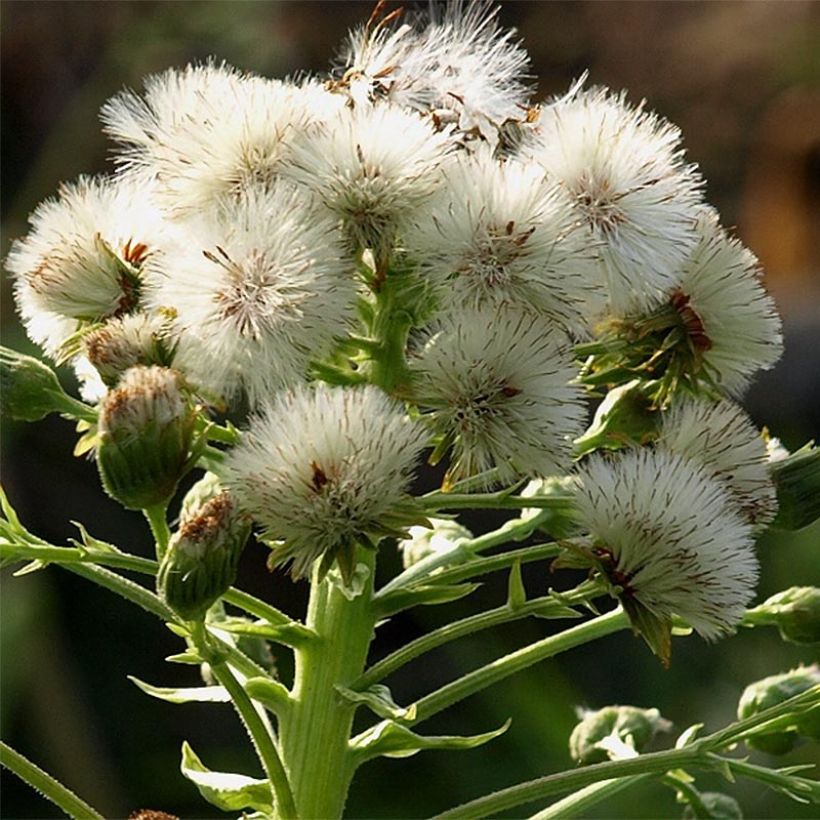

Flowering
Foliage
Plant habit
Botanical data
Petasites
japonicus
Giganteus
Asteraceae
Pétasite du Japon, Fuki
Cultivar or hybrid
Other Petasites
Planting and care
The Petasites japonicus 'Giganteus' can be easily cultivated in shade or partial shade, in a consistently moist or even wet, chalky, neutral or acidic soil. It is hardy to at least -20 °C (- 4°F) and can tolerate a sunny exposure if the soil is very moist. Limit its lateral growth by digging around the planting area in early spring, on the periphery, to remove any wandering rootstocks.
Planting period
Intended location
Care
-
, onOrder confirmed
Reply from on Promesse de fleurs
Spring flowering perennials
Haven't found what you were looking for?
Hardiness is the lowest winter temperature a plant can endure without suffering serious damage or even dying. However, hardiness is affected by location (a sheltered area, such as a patio), protection (winter cover) and soil type (hardiness is improved by well-drained soil).

Photo Sharing Terms & Conditions
In order to encourage gardeners to interact and share their experiences, Promesse de fleurs offers various media enabling content to be uploaded onto its Site - in particular via the ‘Photo sharing’ module.
The User agrees to refrain from:
- Posting any content that is illegal, prejudicial, insulting, racist, inciteful to hatred, revisionist, contrary to public decency, that infringes on privacy or on the privacy rights of third parties, in particular the publicity rights of persons and goods, intellectual property rights, or the right to privacy.
- Submitting content on behalf of a third party;
- Impersonate the identity of a third party and/or publish any personal information about a third party;
In general, the User undertakes to refrain from any unethical behaviour.
All Content (in particular text, comments, files, images, photos, videos, creative works, etc.), which may be subject to property or intellectual property rights, image or other private rights, shall remain the property of the User, subject to the limited rights granted by the terms of the licence granted by Promesse de fleurs as stated below. Users are at liberty to publish or not to publish such Content on the Site, notably via the ‘Photo Sharing’ facility, and accept that this Content shall be made public and freely accessible, notably on the Internet.
Users further acknowledge, undertake to have ,and guarantee that they hold all necessary rights and permissions to publish such material on the Site, in particular with regard to the legislation in force pertaining to any privacy, property, intellectual property, image, or contractual rights, or rights of any other nature. By publishing such Content on the Site, Users acknowledge accepting full liability as publishers of the Content within the meaning of the law, and grant Promesse de fleurs, free of charge, an inclusive, worldwide licence for the said Content for the entire duration of its publication, including all reproduction, representation, up/downloading, displaying, performing, transmission, and storage rights.
Users also grant permission for their name to be linked to the Content and accept that this link may not always be made available.
By engaging in posting material, Users consent to their Content becoming automatically accessible on the Internet, in particular on other sites and/or blogs and/or web pages of the Promesse de fleurs site, including in particular social pages and the Promesse de fleurs catalogue.
Users may secure the removal of entrusted content free of charge by issuing a simple request via our contact form.
The flowering period indicated on our website applies to countries and regions located in USDA zone 8 (France, the United Kingdom, Ireland, the Netherlands, etc.)
It will vary according to where you live:
- In zones 9 to 10 (Italy, Spain, Greece, etc.), flowering will occur about 2 to 4 weeks earlier.
- In zones 6 to 7 (Germany, Poland, Slovenia, and lower mountainous regions), flowering will be delayed by 2 to 3 weeks.
- In zone 5 (Central Europe, Scandinavia), blooming will be delayed by 3 to 5 weeks.
In temperate climates, pruning of spring-flowering shrubs (forsythia, spireas, etc.) should be done just after flowering.
Pruning of summer-flowering shrubs (Indian Lilac, Perovskia, etc.) can be done in winter or spring.
In cold regions as well as with frost-sensitive plants, avoid pruning too early when severe frosts may still occur.
The planting period indicated on our website applies to countries and regions located in USDA zone 8 (France, United Kingdom, Ireland, Netherlands).
It will vary according to where you live:
- In Mediterranean zones (Marseille, Madrid, Milan, etc.), autumn and winter are the best planting periods.
- In continental zones (Strasbourg, Munich, Vienna, etc.), delay planting by 2 to 3 weeks in spring and bring it forward by 2 to 4 weeks in autumn.
- In mountainous regions (the Alps, Pyrenees, Carpathians, etc.), it is best to plant in late spring (May-June) or late summer (August-September).
The harvesting period indicated on our website applies to countries and regions in USDA zone 8 (France, England, Ireland, the Netherlands).
In colder areas (Scandinavia, Poland, Austria...) fruit and vegetable harvests are likely to be delayed by 3-4 weeks.
In warmer areas (Italy, Spain, Greece, etc.), harvesting will probably take place earlier, depending on weather conditions.
The sowing periods indicated on our website apply to countries and regions within USDA Zone 8 (France, UK, Ireland, Netherlands).
In colder areas (Scandinavia, Poland, Austria...), delay any outdoor sowing by 3-4 weeks, or sow under glass.
In warmer climes (Italy, Spain, Greece, etc.), bring outdoor sowing forward by a few weeks.

































